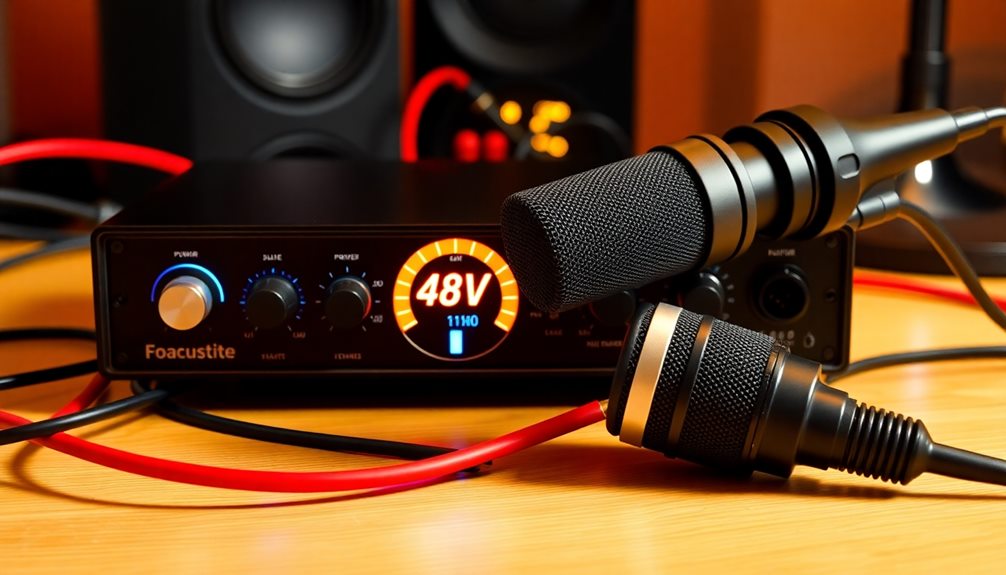When you see 48V on your Focusrite gear, it means your device is providing phantom power! This power is essential for condenser microphones, helping them capture sound in rich detail. Instead of using bulky external power supplies, 48V simplifies your setup. Remember, though, dynamic microphones don't need this power, and some ribbon mics require extra care. Before connecting, always turn off phantom power to protect your gear. Once everything's connected, you can switch it on for great audio. Curious about more tips and tricks? There's plenty to discover about using your Focusrite for the best sound!
Key Takeaways
- 48V refers to phantom power required to operate condenser microphones connected to Focusrite audio interfaces.
- It eliminates the need for external power supplies, simplifying audio setups.
- Focusrite devices allow individual activation of phantom power for each microphone channel.
- Always turn off phantom power before connecting microphones to avoid equipment damage.
- Proper voltage ensures optimal performance, maintaining sound quality during recordings.
Understanding 48V Phantom Power
Understanding 48V phantom power is essential for anyone working with condenser microphones. This special power source helps your microphones function properly by delivering the energy they need to work. When you connect a condenser mic using a balanced XLR cable, the 48V phantom power charges the diaphragm and powers the internal preamps. This means your microphone can produce high-quality sound!
What's great about 48V phantom power is that it eliminates the need for bulky external power supplies. This makes your setup simpler and cleaner, whether you're in the studio or performing live. Plus, it delivers consistent voltage, so you don't have to worry about sound quality dropping.
Keep in mind, most condenser microphones need this power, but dynamic microphones don't. They're versatile and can work without it!
However, be cautious when using ribbon mics. They can be sensitive to phantom power, so it's best to turn it off before connecting or disconnecting them. With this knowledge in hand, you'll be ready to make the most of your audio equipment and create amazing soundscapes!
Importance of Phantom Power

Phantom power's importance in audio production can't be overstated, especially when it comes to using condenser microphones. This +48V power is what makes these microphones work! It charges the diaphragm, letting them capture sound beautifully. Plus, it powers their internal preamps.
Using phantom power also means you don't need bulky external power supplies, which keeps things neat and tidy. It travels through balanced XLR cables, guaranteeing your audio signals stay clear and strong.
Here's a quick look at the benefits of phantom power:
| Feature | Benefit | Consideration |
|---|---|---|
| Powers Condenser Mics | Essential for quality sound capture | Always verify phantom power is on for use |
| Eliminates External Supplies | Streamlines your audio setup | Less clutter means easier management |
| Safe with XLR Cables | Transmits audio without interference | Check connections to avoid issues with older gear |
Understanding phantom power helps you connect your microphones properly. Just remember, always turn it off when connecting sensitive equipment like older ribbon microphones to avoid damage. Enjoy your audio adventures!
Types of Microphones
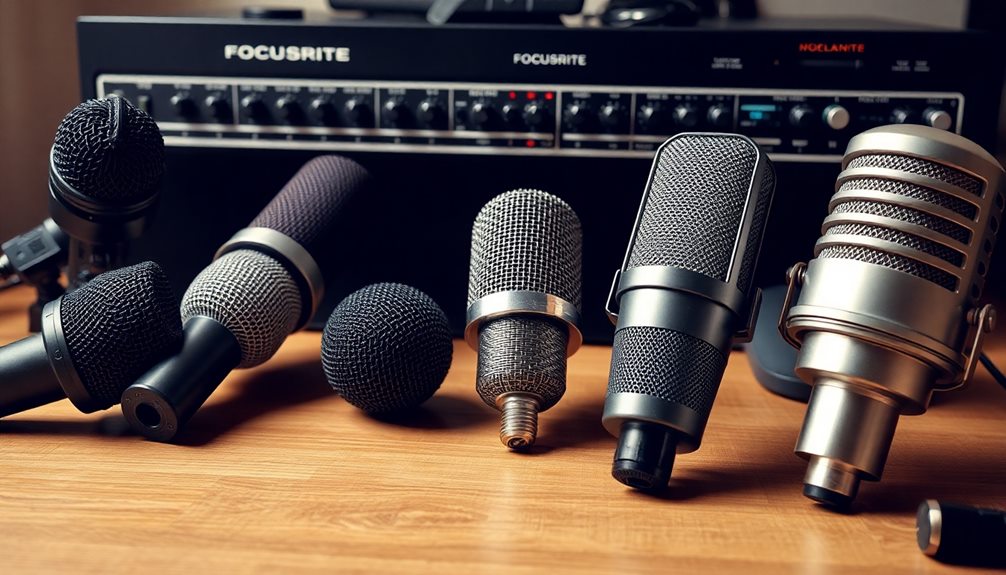
Let's explore the different types of microphones you might encounter!
Dynamic microphones are tough and perfect for live shows since they don't need any extra power.
On the other hand, condenser microphones are super sensitive and require phantom power like +48V, making them great for capturing all the little details in a studio.
Dynamic Microphones Overview
Dynamic microphones play an essential role in both live performances and studio recordings, thanks to their robust design and ability to handle high sound pressure levels. They're perfect for capturing vocals and instruments without getting overwhelmed by loud sounds.
What makes them even better is their durability and ability to block out background noise. Unlike condenser microphones, dynamic microphones don't require phantom power, meaning you can easily connect them without any extra fuss. This makes them an ideal choice for beginners who are just starting to explore audio recording and performance, as they provide a user-friendly experience without complicated setups.
Additionally, understanding the importance of parenting tips and advice can help new parents make informed decisions about their child's exposure to sound and music.
Here are some common types of dynamic microphones you might find:
- Handheld models for live singing
- Instrument mics for amplifying guitars and drums
- Shotgun mics for focused sound capture in film and video production
With their affordability, dynamic microphones are a great choice for beginners and pros alike. You'll enjoy using them in various audio setups, whether you're recording in a studio or performing on stage.
Condenser Microphones Necessity
Condenser microphones are essential tools in the audio recording world, especially for capturing detailed and nuanced sound. Unlike dynamic microphones, condenser mics need phantom power to work. This is because they've a special diaphragm and backplate that convert sound into electrical signals. To do this, they require an electrical current of +48V, which helps polarize the transducer inside.
Additionally, glycolic acid benefits can be likened to how condenser mics enhance audio clarity; both improve the quality of their respective mediums through effective mechanisms.
Phantom power is usually provided through balanced XLR cables. This means that while the microphone gets the power it needs, the audio signal stays clear and strong. Isn't that cool? Many professionals love using condenser mics in studios because they pick up every little detail, making your recordings sound amazing.
It's important to remember that not all microphones need phantom power. For example, ribbon microphones can use it too, but be careful! If you have a passive ribbon mic, phantom power can actually damage it.
Best Practices for Using Phantom Power
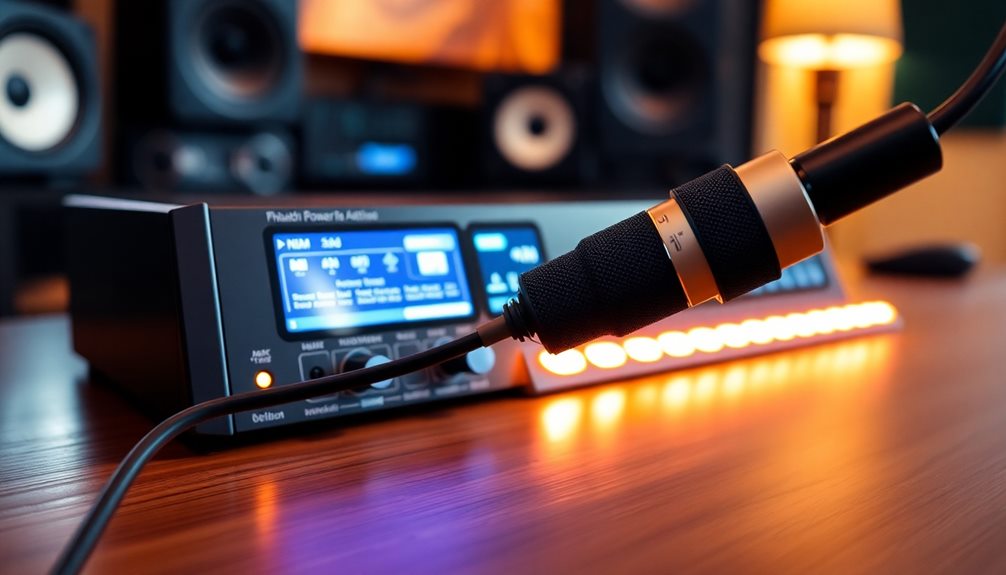
When using phantom power, it's super important to connect your microphones with the power turned off first.
This helps avoid any noise issues or potential damage.
Safe Connection Practices
Connecting microphones safely is essential for maintaining audio integrity and preventing equipment damage. When using phantom power, it's important to follow some best practices. Here are a few tips to guarantee a safe connection:
- Always turn off phantom power before plugging in your microphones. This helps avoid any potential damage or annoying noise.
- Connect all devices to your audio interface first. This way, you can activate phantom power without interrupting the signal.
- Disable phantom power when using ribbon microphones, especially vintage models. They're sensitive, and phantom power can cause harm.
Engaging phantom power only when needed is a smart move. Leaving it on can stress your microphone and preamp circuitry over time.
Also, make sure you know the specifications of your microphones and interface. This knowledge helps you understand the correct phantom power requirements and avoid compatibility issues.
Powering Devices Efficiently
Using phantom power efficiently is essential for getting the best performance from your microphones.
First, always connect your microphones with phantom power turned off. This protects sensitive equipment, especially ribbon microphones, from damage. Once everything is connected, you can activate the 48V phantom power. This keeps your audio safe and clear!
Using balanced XLR cables is also really important. They help maintain a clean signal path and prevent interference, so your audio sounds great.
Make sure to check your microphone's specifications. Condenser mics need phantom power, but dynamic mics don't, so be aware!
It's also a good idea to regularly verify that your audio interface or mixer is supplying the correct +48V phantom power. Sometimes, older or broken gear can provide insufficient voltage, which can affect your sound quality.
Compatibility With Focusrite Gear
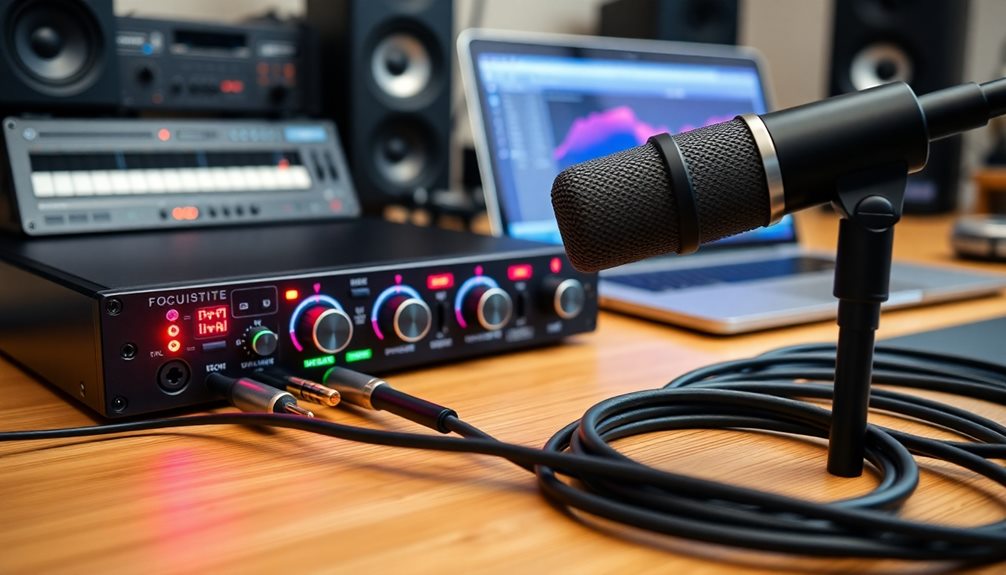
While many modern microphones seamlessly integrate with Focusrite gear, it's crucial to guarantee compatibility, especially with older models.
Focusrite interfaces provide 48V phantom power, which is essential for operating condenser microphones. This feature guarantees your mic functions efficiently during recording sessions. However, you should always check the specifications of older ribbon microphones, as they mightn't be compatible and could get damaged.
Here are a few tips to help you ensure compatibility:
- Check specifications: Always verify the microphone's requirements before connecting it to your interface.
- Use Focusrite Control software: This handy tool lets you retain the last used state of the 48V feature, making your setups super convenient.
- Activate phantom power individually: Each channel on your Focusrite device can have phantom power activated separately. This way, you can control which microphones receive power!
Troubleshooting Common Issues
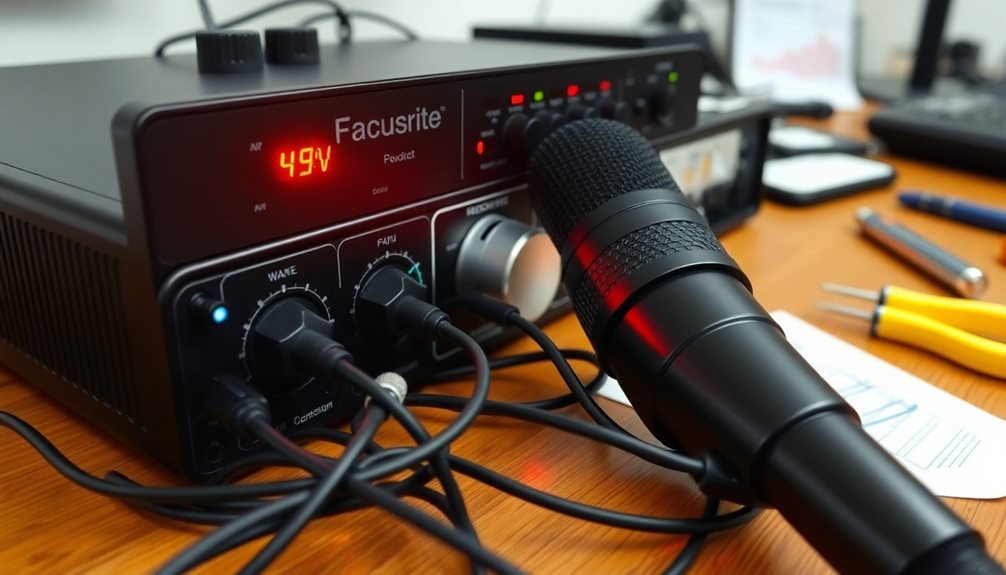
Often, users encounter common issues when working with their Focusrite interfaces that can disrupt their recording experience. If you're getting little or no signal from your microphone, first, check all your hardware connections. Make sure the microphone is detected by your Focusrite interface.
Next, verify that your firmware is up to date. Outdated firmware can create compatibility issues with phantom power. It's also crucial to check that the sample rate, bit depth, and buffer size match your interface's specifications.
If your condenser mic still isn't working despite phantom power being on, the power supply might not be delivering enough voltage. Older interfaces sometimes struggle with this.
Here's a quick troubleshooting table to help you:
| Issue | Solution |
|---|---|
| Little or no signal | Check connections and settings |
| Phantom Power turns off | Confirm power supply is adequate |
| Persistent problems | Contact Technical Support |
If you still can't resolve the issue, don't hesitate to contact Focusrite Technical Support. They can provide tailored assistance for your specific setup, guaranteeing you get back to recording with joy!
Additional Resources and Reading

After addressing common issues with your Focusrite interface, it's helpful to explore additional resources that can enhance your recording experience.
Whether you're new to using 48V Phantom Power or just need a refresher, these resources can make a big difference.
Here are a few suggestions to evaluate:
- Focusrite Control Software: This handy tool lets you manage your 48V settings easily. You can even save the last used state for your microphones.
- User Guide: Don't forget to check the user guide for your specific Focusrite model. It's packed with tips on how to use 48V power safely, especially for sensitive equipment like ribbon microphones.
- Online Tutorials: Plenty of tutorials are available online, providing step-by-step guides on setting up and troubleshooting your interface.
Frequently Asked Questions
What Does 48V Mean on Focusrite?
When you see 48V on your Focusrite interface, it means it's providing phantom power. This power's essential for condenser microphones, allowing them to work properly and deliver high-quality audio signals during your recordings.
What Does 48V on an Audio Interface Do?
When you activate 48V on your audio interface, it powers condenser mics like the AKG C214. This phantom power transmits through XLR cables, ensuring your recordings capture crisp, clear audio without needing external supplies.
Why Do Microphones Use 48V?
Microphones use 48V to power their internal components effectively. This voltage polarizes the diaphragm in condenser mics, enhancing sound wave conversion into electrical signals, ensuring you capture high-quality audio without needing bulky external power sources.
Should 48V Be On?
Should you keep 48V on? Imagine your audio setup like a car; only use the ignition when necessary. Activate 48V for condenser mics, but turn it off for dynamic or passive ribbon mics to prevent damage.
Conclusion
To sum up, understanding 48V phantom power is like opening a treasure chest for your microphones! It helps them shine bright and sound their best. By following best practices and ensuring compatibility with your Focusrite gear, you can create amazing recordings. Don't forget to troubleshoot any hiccups along the way, so your audio journey stays smooth. Now, go ahead and power up your mic, and let your creativity flow like a sparkling river of sound!
